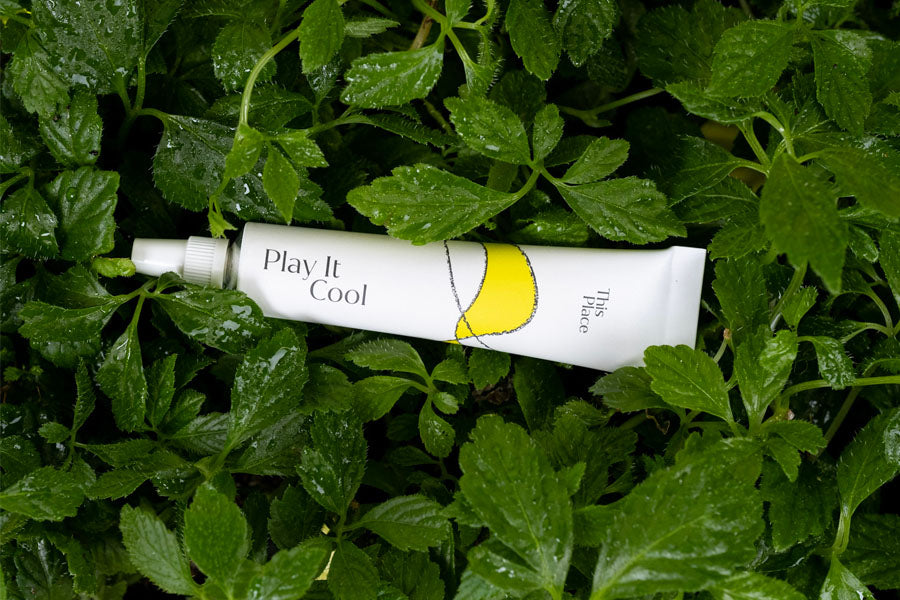Part 7 of “Inside is what's good. For you and your skin” series by This Place
Would you like to better understand the ingredients list of your cosmetics? Check out our series of articles, “What's good is inside. For you and your skin.” by This Place.
We kicked the series off with Bakuchiol – a plant that has only recently been celebrated as a hero ingredient. You can access the other articles via the links at the bottom of the page.
Similar to bakuchiol, jiaogulan is one of those "tongue-twisting" skincare ingredients. For those wondering how to pronounce the herb, it's “Je-ow-gu-laan”.
But while bakuchiol has already established itself as a natural alternative to retinol, jiaogulan is still rarely found on the ingredient lists of European beauty brands.
Let's be clear: this is not due to a lack of effectiveness. After all, it is not a coincidence that jiaogulan is one of the Hero Ingredients in Play It Cool.
Like all This Place products, the strengthening eye gel was designed on the basis of current research findings, true to our belief in innovative botanical ingredients. And after thorough research, one thing is certain for us: When it comes to skincare, Jiaogulan is a superstar.
In this article, you'll find out why it's worth integrating the strengthening herb from China into your skincare routine from now on:
- Active Ingredients in Gynostemma Pentaphyllum
- Why Jiaogulan is a Skincare Hero for Us
- Jiaogulan in Play it Cool - Your Kickstarter for Tired Eyes
- Conclusion on Jiaogulan: How the Strengthening Plant can improve Your Skin Texture
Active Ingredients in Gynostemma Pentaphyllum
"Ginseng of the south, woman's ginseng, 5-leaf ginseng": these are three nicknames of the climbing plant which bears the botanical name Gynostemma Pentaphyllum. [9] Better known as jiaogulan, the herb, which is native to the southern mountain regions of China [14], is rarely mentioned without reference to Asian ginseng.
Yet the two plants are not botanically related at all. While ginseng is a member of the Araliaceae family [3], jiaogulan belongs to the Cucurbitaceae family [2].
The name reference has another reason: the leaves of jiaogulan contain a number of ingredients that are similar or even identical to those of the ginseng root. [9] In ginseng, these important active ingredients are called ginsenosides, while related substances in jiaogulan are called gypenosides.
Because of their similar structure, gypenosides and ginsenosides often have a comparable effect in the body and on your skin. [14]
But while Asian ginseng can proudly consider itself to be one of the most important plants in traditional Chinese medicine, the effects of jiaogulan on the body and skin have only been studied extensively for a few decades.
Why Jiaogulan is a Skincare Hero for Us
And yet, "Gynostemma Pentaphyllum Leaf/Stem Extract" can keep up with the effect of popular ingredients such as niacinamide, vitamin C, azelaic acid and such.
Jiaogulan extract has antioxidant and cell-protective effects. Additionally, it can prevent the first signs of skin aging and help to reduce redness in your skin.
But let's take a look at the current research together:
Jiaogulan as Protection from UV radiation
There are numerous studies that have investigated the UV-protective properties of jiaogulan on human cell models. Researchers agree that treating cells with an extract of the medicinal plant can significantly increase their tolerance of UV radiation. [13]
Since up to 90% of the symptoms of skin aging are caused by ultraviolet light [17], jiaogulan could therefore also help to slow down the aging process of your skin.
Jiaogulan as Protection against Free Radicals
One of the reasons why UV radiation is so harmful is because it promotes the formation of so-called free radicals in your skin. These can attack your cells and thus accelerate skin aging or trigger inflammation.
Besides solar radiation, environmental pollution, physical stress and the consumption of cigarettes or alcohol can also stimulate the formation of free radicals in your skin.
Due to its high antioxidant content, the immortality herb can effectively scavenge these free radicals and thus protect your cells from their harmful effects. [8; 13]
Well-Aging with Jiaogulan
A Korean study investigated the preventive effect of a jiaogulan cream on skin aging. The test subjects aged 21 to 34 years showed no visible wrinkles, but a measurement of the skin density indicated that the aging process of their skin had already begun when the study started. [1]
Your skin density is proportional to the amount of collagen and elastin in your skin. These are proteins that are essential for the firmness and elasticity of your skin. The body's production of these proteins steadily decreases with age. So researchers think that by measuring skin density, you can determine whether the aging process has already begun.
The study participants treated their skin for 4 to 8 weeks with a cream containing either jiaogulan or a placebo. The use of the cream with Gynostemma pentaphyllum significantly reduced the decrease in skin density and thus the progression of skin aging compared to the control group. [1]
The anti-inflammatory effect of jiaogulan in atopic dermatitis
Atopic dermatitis is a chronic inflammatory disease of the skin . Although it affects up to 20% of people worldwide, there is still no efficient treatment option with few side effects.
There are various factors that promote the inflammatory reaction of the skin in atopic dermatitis. These include the two proteins TSLP (thymic stromal lymphopoietin) [6] and IL-33 (interleukin-33) [5]. In a Korean study on isolated cell cultures, the herb of immortality was able to significantly reduce the formation of TSLP and IL-33 and thus the inflammatory reaction of the skin. [15]
The bacterium Staphylococcus aureus can also cause inflammation of the skin in atopic dermatitis. [16]
In another study, jiaogulan was able to mitigate the bacterium-triggered damage to keratinocytes, the cells of the top layer of your skin. In addition, the results of the study suggest that the herb may strengthen your skin barrier and alleviate allergic reactions. [10]

Jiaogulan in Play It Cool - Your Kickstarter for Tired Eyes
If you're wondering how to incorporate the herb of immortality into your skincare ritual from now on, look no further. Allow us to introduce you to Play it Cool.
Inspired by the power of chinese medicinal plants, This Place has developed a naturally strengthening eye gel with extracts of Jiaogulan and Red Ginseng that will have your eye area looking awake, nourished and moisturised in no time:
- Red ginseng supports the collagen production [11] of your skin and can promote the visual brightening of pigmentation spots [18]
- Jiaogulan can prevent early signs of aging thanks to its antioxidant [8] and UV-protective [13] capabilities
- Hyaluronic acid improves the moisture balance of your skin's upper layer [7] and helps you achieve a smoother, more supple appearance
- Caffeine can protect your delicate eye area from oxidative stress [12] and premature sun-induced aging [4]
The decongesting effect of Play it Cool combined with mini-lymphatic drainage can also reduce the appearance of tired, swollen eyes.
The light texture doesn't leave a heavy film on your skin and can be used as a make-up primer.
Learn how to turn the moment you apply Play it Cool into a little ritual here.
Conclusion on Jiaogulan: How the Strengthening Plant can improve Your Skin Texture
Similar in effect but lesser known than the ginseng root, the leaves of jiaogulan were used for many centuries exclusively as a folk medicinal herb of certain regions in China.
In the 1970s, the plant, which has since been known as the herb of immortality, attracted attention in Europe for the first time. You can learn more about how this came about - as well as the history and folk-medicinal use of Jiaogulan - here.
As an ingredient in your cosmetic products, "Gynostemma Pentaphyllum Leaf/Stem Extract" protects your skin from UV-radiation [13] and free radicals. [8; 13] In addition, studies suggest that the plant may prevent skin ageing [1], fight inflammation [15] and support the skin barrier as well as its regeneration [10].

